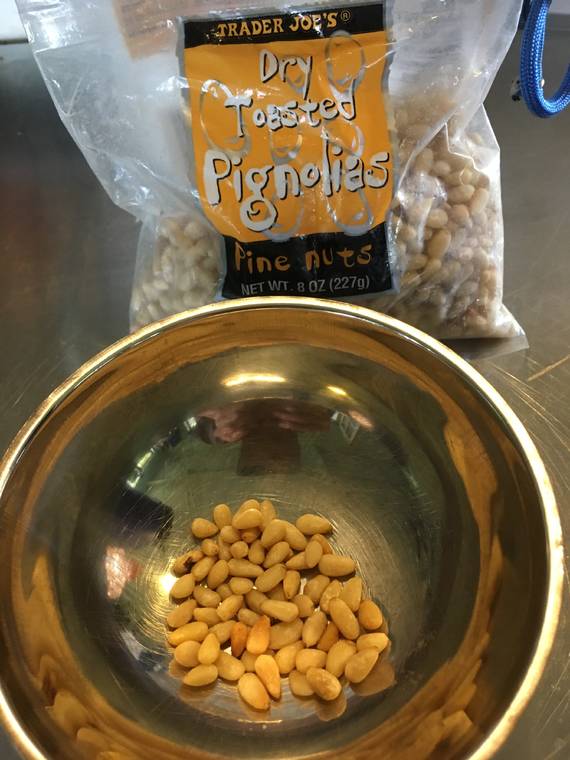Pine nuts have been a staple ingredient in Italian cuisine since the days of ancient Rome. Roman soldiers ate them as they marched into battle. At Pompeii, archaeologists found pine nuts in the volcanic ash.
Pine nuts are so important to the Italians that in 1666, to ensure a steady supply of them, the pope decreed an entire plantation of them be planted on the coast near Rome.
In Tuscany, pine nuts ae baked into pastries, they are roasted with meat in Umbria and added to seafood in Sicily.
Today, we can find pine nuts in Greek, Turkish and Middle East cuisine. Even Native Americans from Mexico to Idaho ate pine nuts for thousands of years. It is the winter staple for the Navajo, and the Pueblo believe a pine nut and a beautiful virgin gave birth to their god-king Montezuma.
I grew up eating pine nuts in the shell that we bought from the Chinese seed store, as it was one of my mother’s favorite snacks. We would crack the shell in half with our teeth and remove the delicious nut inside. These nuts came from China, where they have been grown and harvested since the seventh century. Today, China is the largest producer of pine nuts, exporting more than 2 million pounds to the United States.
The package of pine nuts, quite pricey, from Costco is from China, while an 8-ounce package of dry roasted pignolias, or pine nuts, from Trader Joe’s is smaller and sourced from Korea, Russia and Vietnam and roasted in the U.S.
Harvesting has not changed since ancient times. It is labor intensive, as the trees are either shaken or prodded by long, hooked poles in order to knock down the cones. The cones are then heated, softening their shells to allow the kernels to be removed and deskinned. Although all pine trees have nuts, there are only a few species that produce the flavorful nuts that are eaten.
A bag of pine nuts is so precious, like a bag of gold to me, that I freeze them so they stay fresh and always available when I need them. With the current U.S. and China tariffs, I surely hope pine nuts do not soon cost as much as gold though!
A must in making authentic pesto are pine nuts. Here is a recipe for great basil pesto:
Pesto Authentico
Basil Pesto
Makes: 2 cups
For best results, make by hand with a mortar and pestle. If your mortar is too small to accompany whole basil leaves, use a food processor to gently and minimally chop leaves before proceeding. Pesto is best used the same day but keeps. Cover the surface with a thin layer of olive oil and keep it tightly covered, chilled, for three days. To dress pasta, dilute pesto with a tablespoon or two of pasta cooking water, toss with hot pasta just cooked and drained, add a tablespoon or two of butter and toss again. Serve at once.
1/4 cup pine nuts
2 cups tightly packed basil leaves
2 garlic cloves, lightly smashed, peel removed
Coarse sea salt
6 tablespoons freshly grated Parmigiano-Reggiano cheese
2 tablespoons freshly grated pecorino romano cheese
1/2 cup extra virgin olive oil
Place pine nuts in a medium skillet and heat over medium-low heat. Cook, shaking occasionally, with a back and forth motion until nuts are toasted, 6-8 minutes. Transfer nuts to a plate to cool completely.
Rinse basil leaves and gently, but thoroughly, pat dry with paper towels. Place in a mortar, add cooled pine nuts, garlic and pinch of salt. Using the pestle with a rotary movement, grind ingredients against the wall of the mortar until ground to a paste. Add both cheeses and grind into mixture to combine.
Transfer mixture to a large bowl. In a slow and steady stream, add oil, whisking constantly until blended.
Pollo Alla Pancetta, Erbette e Pinoli
Chicken with Pancetta, Swiss Chard, and Pine Nuts
Serves: 4
8 skinless, boneless chicken thighs
Freshly ground black pepper
1 orange
2 tablespoons extra-virgin olive oil
1 garlic clove, thinly sliced
1 1/3 pounds Swiss chard, roughly chopped
Salt to taste
2 tablespoons pine nuts
Heat oven to 400 degrees. Season chicken with pepper and wrap with pancetta. Place in a baking dish. Bake until browned, about 20 minutes.
While chicken is baking, cut a 1-inch wide strip of peel from an orange, avoiding the white, bitter pith, and slice thinly (a potato peeler would do the job). Set sliced peel aside. Squeeze juice from orange.
Remove chicken from oven. In a large skillet, heat oil over medium heat. Add garlic slices, cook, stirring, until softened, about 5 minutes. Add chard and orange peel; cook, stirring, until chard is wilted, about 5 minutes. Season with salt.
Transfer chicken to skillet with chard, add orange juice and pine nuts, bring to gently simmer over medium-low heat. Cover and cook until chicken is cooked through and flavors have blended, about 10 minutes.
Foodie bites
Costco now has the whole wheel of Parmigiano-Reggiano cheese for about $900. It is 72 pounds and advertised as “aged for 24 months” and “imported from Italy.” You only need to find refrigeration once you cut it open.
The Hawaii Community College Cafeteria is now open from 10:30 a.m.-12:30 p.m., but will closed tomorrow through Friday. Next week, the Cafeteria will be open Tuesday through Friday. Take-out orders are welcome. Call 934-2559.
Two choice combinations are now available for any of the four entrees served daily. Prices vary.
Call to inquire about desserts for the day (pies, cakes, cookies).
Email Audrey Wilson at audreywilson808@gmail.com.

